With the legs in-hand it was time to build the writing box that went on top of them. Again using mostly southern yellow pine from my pile I set to work. It was straightforward but had to fit the legs precisely. I dispensed with making the bow-front drawer for the box as it would be predetermined by the box itself.

To get practice for the re-sawing that would come soon in prized vintage mahogany I did that with this tulip poplar stock.
The joinery for the box was mundane but a necessary exercise.
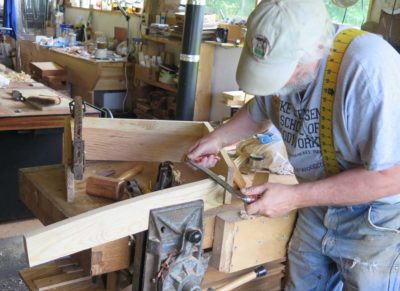
I established the curve of the drawer frame and the top with drawknife and spokeshave.

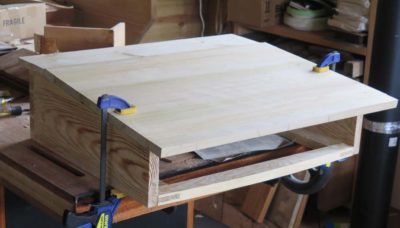
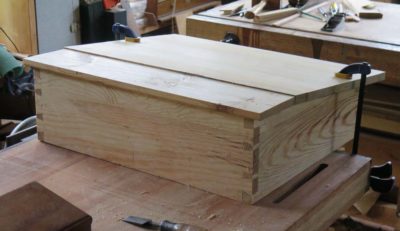
And put it together. The writing surface was simply tacked in place with finishing nails as I would need to remove it to check the internals once the real project was underway. On that version the top would be glued in place with glue blocks.
Up next: joining the legs, box and shelf to finish the prototype.

In recent years my projects and inclinations have guided me towards more diminutive work in thinner stock. This makes cutting dovetails somewhat of a challenge when using a standard saw, which is often too aggressive and thus harder to control effortlessly. As a result of that I began exploring the prospect of fabricating my own petite dovetail saw. I wound up making several with good-to-excellent results. We will replicate that process and send you home with your own.
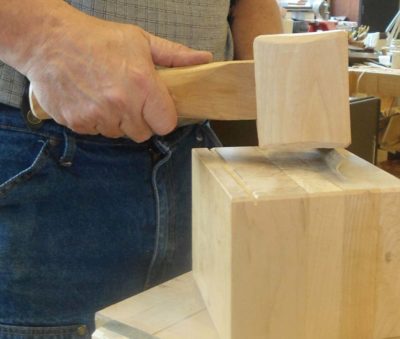

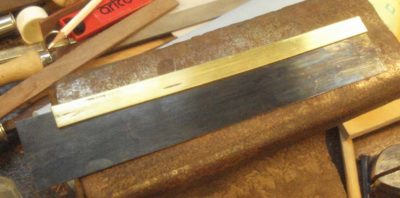


If you have a particular piece of wood to use for the handle (tote) feel free to bring it to work with. Otherwise I will provide all the materials for this workshop. We’ll aim to fold and finish the back, taper and insert the plate/blade, fit and fashion the handle to your hand, and file the teeth.
The tool list for the workshop is a short one and will be sent to attendees well before the event.
****************************************************
The complete 2018 Barn workshop schedule:
Historic Finishing April 26-28, $375
Making A Petite Dovetail Saw June 8-10, $400
Boullework Marquetry July 13-15, $375
Knotwork Banding Inlay August 10-12, $375
Build A Classic Workbench September 3-7, $950
It’s been more than four months since I last wrote about my project to interpret an early 19th century writing desk for a client, when I had the opportunity to use period appropriate technology for virtually the entire project. Previously I had written about deriving the design templates for the project, and this post will finally get down to fashioning wood.

My first problem(?) was that I was a bit hazy on some of the internal construction details of the original. To resolve that void, or to at least come to a workable conclusion, I needed to build a full scale prototype. Using some left over 2x SYP from a workbench-building project I did just that. I rough cut each leg element with a bandsaw (this was primarily a proportion and joinery exercise) then shaped them just enough to get the gist of the idea.
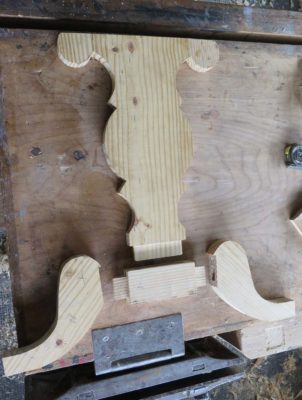
Then with each individual element fashioned I dove into the joinery for the complete leg assembly, with frequent dry fittings.

Using PVA I glued up each leg.
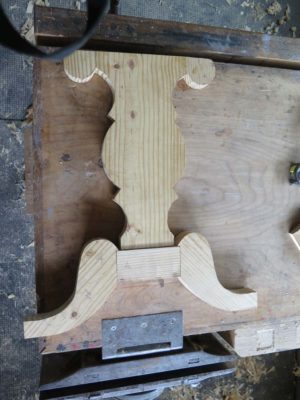
In the end I had two leg assembles shaped and fashioned, and joined, glued, and assembled. This was an important moment as I exerted my full weight on each individual leg to make sure they would hold.
They did.

April 26-28 Historic Finishing – My own long-time favorite, we will spend three days reflecting on, and enacting, my “Six Rules For Perfect Finishing” in the historic tradition of spirit and wax coatings. Each participant may bring a small finishing project with them, but I have found that invitation to have erratic responses so the workshop will focus on creating numerous sample boards to keep in your personal collections. Tuition $375.
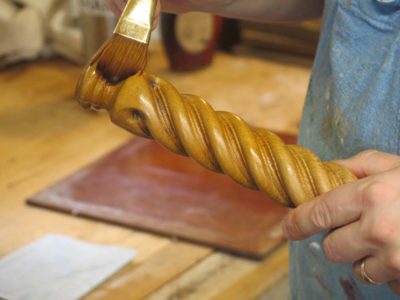
***********************************************
The complete 2018 Barn workshop schedule:
Historic Finishing April 26-28, $375
Making A Petite Dovetail Saw June 8-10, $400
Boullework Marquetry July 13-15, $375
Knotwork Banding Inlay August 10-12, $375
Build A Classic Workbench September 3-7, $950
If any of these interest you, contact me here.

One of my long-time interests has been the iconic “Elastic Chair” of Boston chair maker Samuel Gragg, who produced these sinuous featherweight painted chairs for a few short years somewhere in the window of 1805-1815. Having made a few myself I can see why he switched to technically simpler chairs, but I remain smitten by the form.
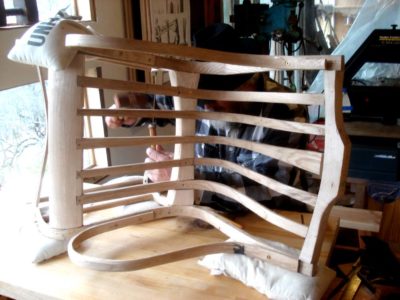
At one of the woodworking events in the past I had my Gragg chair there with me on display, and at some point I was absent from its presence and someone sat in the chair who shouldn’t have. The first hand accounts ex poste indicate that the offender was so corpulent (first hand accounts would suggest said person was well north of four bills) that he could not get out of the chair as his flesh has drooped over the seat rails and filled the void of the arms and even below the arms. He was wedged in tight as could be. In the desperate struggle to get out of the chair where he was not supposed to be, the occupant apparently put his forearms on the chair arms with the all the force he could muster on the arms of the chair to pry himself out of it. He was evidently successful in that his bloated dead carcass was not in the chair afterward, but in extricating himself he managed to fracture both arms. Of the chair. He fled the scene with nary a word of acknowledgment nor apology.

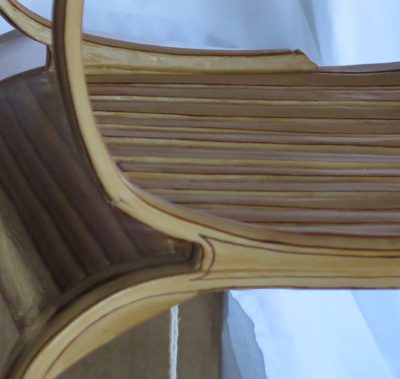
After contemplating a solution for the time since and seeing a bit of clear sky in my upcoming schedule (and to get warmed up to build two elastic chairs that I’ve been commissioned to make, but more about that later) I have now decided to undertake the repair. Even though it is something I made myself, thus disposable, I will endeavor to follow the same decision framework I’ve used for for four decades on museum and client artifacts, just to make it interesting. It will be a great learning experience for me.
Stay tuned.
Many people equate “skill” and “talent.” They are sometimes related, but certainly not the same thing. It is like the modern conflation of “jealousy,” “covetousness, ” and “envy.” All are related as manifestations of the same base impulse, but they are not the same (envy being the most pernicious).
But back to “skill” and “talent.”
I possess precious little artistic talent, but have acquired fair-to-middling creative skills. I remember clearly a session in the studio of one of my art classes in college. I was succeeding in the class by sheer grit and inordinate time working in the studio; the art didn’t flow out of me simply because the talent was not there. But I was determined to succeed and spent untold hours at work there. One day I asked Mrs. Barn to come with me and keep me company as I worked, and as we walked there she picked up a branch of some flowering tree or something. So while I ground away at my “creating” she whipped out a lovely oil painting of the sprig even though she never trained as an artist. But she has sublime artistic talents while I am saddled with a noteworthy lack of them.
I’m not sure if curiosity is a talent, but I do have a fair bit of that. Perhaps my greatest creative gift was that I was an indifferent student in school prior to my third stint in college, when I worked and learned with a vengeance. But middle school and high school? Nah, I did not pay enough attention to enable them to beat the curiosity out of me and I was able to retain my native impulse to color outside the lines.
Talent is, I believe, a portion of that inventory of nascent gifts imparted at our conception as unique creatures, whereas skills are the abilities honed through repetitive exercises. That said, the vocabulary of skills we possess allows us to expand our creative and productive capacity to a nearly limitless vista, and to hone those natural talents.
As a craftsman and teacher that is where I try to invest my resources.

I am at a point in my life where my writing is an output that has value in the marketplace, all the more surprising to me in that I went to gubmint schools at a time when the rigors of language arts were, shall we say, not emphasized. Now I practice writing on a near-daily basis to sharpen my skills of wordsmithing. This occurs on this blog as often as I can even though many acquaintances urge me to de-emphasize my writing here in exchange for “more followers” via other vehicles that do not require anything more than a few pictures and words on a smart phone. I have resisted this for several reasons, not the least of which is I do not have a smart phone and have little interest in getting one given that I live in a place with almost no cell service. Second, if my goal is to increase my ability in crafting words, I’d better spend some time crafting words rather than avoiding it. An analogy would be encouraging someone to refine their joinery skills at the workbench by giving them a screw gun.
Instead, for the time being I prefer to write short articles for this blog a few times a week as a means of not only connecting with those who read it but also accomplishing the not-so-unintended-consequence of improving my own writing skill set. I know I will never become as facile as Chris Schwarz given both his natural talents and honed skills that enable him to have a daily output capacity of probably four thousand words. I hope for a tenth of that, and dream of a quarter, a pace I actually maintained while writing the 40,000 word first draft manuscript of Virtuoso in six weeks.
For the past few years I have endeavored to write something every day. A blog essay, even if only a short one, or at least a portion of one (some blogs take a few sessions of verbal noodling). Or another portion of my ongoing book manuscript, at present The Period Finisher’s Manual (I am targeting the end of the year for its completion). Some mystery/thriller fiction, currently about a derelict antiques restorer out in the mountains and how he eventually saves the world. Blowing off steam by recording pithy observations about the state of the world around me.
It is all enjoyable and ruthlessly demanding, but it is how I am building my muscles in formulating and organizing ideas and putting them into words.
Simply put, the regimen makes me more skilled at writing.
The same is true with my physical craft. As a furniture maker I will not and probably cannot become Jean-Henri Riesener, John Goddard, Alvar Aalto, or James Krenov. I am unlikely to ever become a truly skilled engraver, or metalsmith, or machinist, or chemical engineer. But I can become better than I am.
And so can you.
While I cannot endow you with creative genius, I can encourage and direct you in the genesis and more full formation of skills through practice and exercise. This has become cemented as the goal for my time in The Barn on White Run; that I explore and create, and share those adventures with you that you might be more encouraged to do the same.
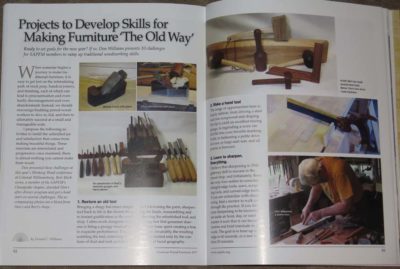
In the coming weeks and months I hope this will become manifest on this blog with my mercurial musings about craft and life on the homestead being augmented with more postings about the processes of doing and not just my noumena. One iteration of this starting next will be a series of bench exercises I presented at last year’s banquet address for the Colonial Williamsburg Working Wood in the 18th Century shindig.
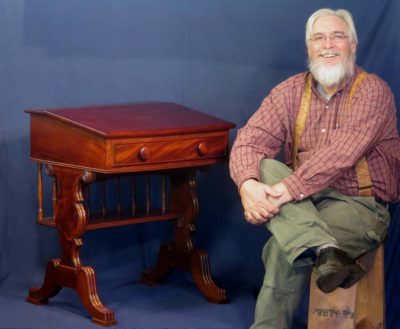
Another will be the multi-part walk-through of interpreting an early 19th century writing desk, of which I have already written a couple of blogs in the past.
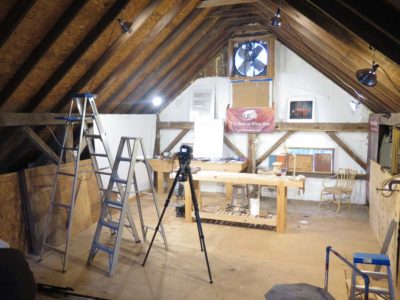
And making instructional videos for distribution with a talented young local film maker.
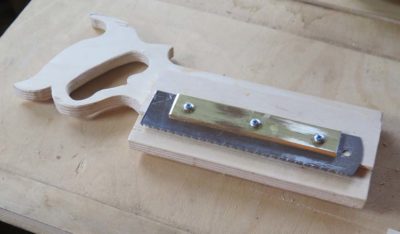
And making and modifying tools.
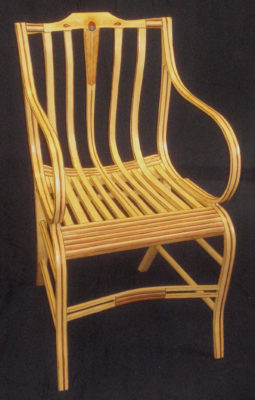
And Gragg chairs.

And workbenches.
And, and, and…
All in pursuit of skills, in service to my “talent.”
As the depths of winter set in out here in the mountains I decided to do something about the problem of early fading light, especially in the great room of the barn’s main floor. On a typical January day I lose direct sunlight by about 3:30, and the darkness creeps in from that point on.

I decided that a big hurdle to solving the problem lay in the fact that the two oversized doors to the barn were visually solid, and that a solution might be to pierce them with large panes of glass. Fortunately I happened to have just one such piece of glass leftover from the original construction a decade ago. It is a piece of salvaged thermal glass from an unremembered source but it was sized as though it was made for the task being contemplated and it seemed as though the project would be easy to undertake and complete.
So I did.

Since I was using the panel of glass essentially as a piece of sheathing the “framing” of the new window was a simple batten screwed to the door so that the panel would have someplace to seat. After the batten frame was in place I sawed out the opening for the window, lifted the new pane into its seat, and added some more temporary battens to the rear side to hold it in place until spring time when the warmer weather will allow me to caulk it in place permanently.

Until then I am enjoying both the doubling of the external light present in that work space, and celebrating the fact that this was one project that turned out to be as simple and quick as I had first imagined. I would like to find another panel the exact same size for the other door, and will keep scouring the salvage yards until I do.
For now, I simply enjoy being able to work in the great room until almost five o’clock.
Recently I was invited to speak about the HO Studley project to the Frederickburg (VA) Woodworker’s Guild. My friend SteveD was my host and a grand time ensued.
While at Steve’s I got to see a bed frame he had been working on in recent weeks, and about which we had corresponded regarding the finish being used. This bed was commissioned by the organization that is recreating George Washington’s childhood home near Fredericksburg. Much of the recreation is based on rigorous and ongoing archaeology. The Washington family domicile being readied for the public is all new construction, but there is solid evidence that it is a very faithful interpretation of the original.

Steve has been commissioned to create a number of beds (and perhaps other pieces?) for the site, and this bed is a stunning one.

The audience at the Guild meeting was large and enthusiastic, Steve said it was about twice normal. And you gotta admit, the tale of Henry O. Studlew is a compelling one. The group meets in a semi-industrial space which suited me just fine.

The audience was very attentive and engaged, asking excellent questions throughout the presentation and staying after to discuss all manner of Studley and Roubo topics. They promised to invite me back, and I look forward to that event.
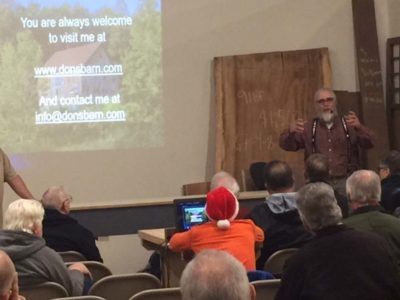
En route back to Shangri-La following our excursion into deepest Flyover Country we stopped to see the progress of things at Lost Art Press. Mrs. Barn had never seen the new World Headquarters and since they were within a mile of our route, I checked to make sure we could stop.
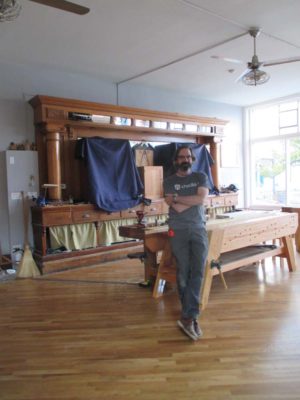
As usual Chris was hard at work in the shop and on the shop, but he took a few minutes to visit and relax.

During that brief visit I sat in the Mother of All Stump Chairs that Chris has been chronicling. I cannot say I could sit there for an entire evening but it was more comfortable than I expected and looked pretty cool too. All I needed was a bearskin vest and a grog of mead and I would have looked right at home.

We also toured the new machine room emerging from the renovation of the carriage house out back, and Chris had just hung and caulked his hand-made doors before we arrived. I definitely approve.
I join Chris in celebrating the establishment of the new headquarters, and even his dream of living in this vintage high density neighborhood. He likes having neighbors nearby, I like having neighbors on the other side of the mountain.

While visiting Mark Harrell recently our conversation returned to a topic we had engaged in previously, namely that of the repertoire of saws in an 18th century Parisian workshop. Whatever they had, Mark wants to try to make it.
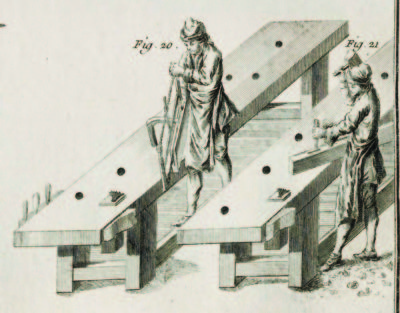
The literary evidence is pretty clear that the workhorse saws in these shops were frame saws for much of the heavy dimensioning (ripping) work and bow saws for the rest, including joinery. (Roubo makes no references to back saws) We might tend to see bow saws as a northern implement, coming from Scandinavian and Germanic traditions, but Roubo places inordinate emphasis on their use and utility in the Paris of his time.


The variations within this theme are many, but at present I am trying to brainstorm about adapting Roubo’s images and descriptions to the tasks of a workshop in 2018. I am starting from the premise that the saw plate Mark developed for the frame saw should serve equally well in a bow saw with the plate fixed parallel to the plane of the frame. With that in mind I have been noodling the designs and begun replicating at least one of a pair of Roubo bowsaws (the other being a compass or “turning” saw, so noted as having a shallow blade that can both follow a curved cut and be rotated in the bow handle for greater facility) in time for demonstrating at CW next week.
Hoping for success. Wish me luck.













































Recent Comments